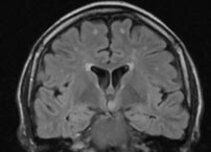Radiosurgery
Radiosurgical treatment of gelastic epilepsies in hypothalamic hamartoma

Hypothalamic hamartomas are the main cause of gelastic epilepsies, that is, epilepsies with laughing seizures. These epilepsies often have a difficult course because of concurrent complex partial seizures as well as seizure falls and secondary generalised tonic-clonic seizures. Further complications are impaired attention, concentration and behaviour.
The diagnosis comprises, in addition to ascertaining the characteristic semiology by video-EEG-Monitoring, a high-resolution MR imaging-based examination of the hypothalamus particularly. Medication treatments are generally ineffective. The operative removal of the hamartoma is considered when it is pediculate (i.e. attached to the hypothalamus by a stalk), but the surgical intervention carries a very high risk of complications when the hamartoma is embedded intrahypothalamically because of the difficulty of accessing it.
Interstitial radiosurgery in hypothalamic hamartoma
Interstitial radiosurgery was performed in our own pilot series at the Freiburg Epilepsy Centre in co-operation with the Department of Stereotactic Neurosurgery (Director: Prof. Dr. V. Coenen). A small radioactive rod (seed) is implanted stereotactically into the centre of the hamartoma where it remains for a period of around three weeks until the intended dose has been delivered. One third of the patients undergoing interstitial radiosurgery work were rendered seizure-free, and a further third experienced only simple partial, mildly debilitating.
First reports about intervention with external radiosurgical procedures (Prof. Régis, Marseille) also report a successful outcome in about half of the treated patients. Successfully treated patients can also benefit the terms of their behaviour. Both procedures can be carried out with the co-operation of the patients and under local anaesthetic. Except for an increase in body weight and a transient disturbance to temperature regulation the procedures do not give rise to any relevant complications.
Treatment Study at the Freiburg Epilepsy Centre

To clarify which procedure represents the best possible treatment for intrahypothalamic hamartomas in gelastic epilepsies, a prospective, randomised comparative study is currently taking place in Freiburg as a co-operation between the Epilepsy Centre, the Department of Radiotherapy and the Department of Stereotactic Neurosurgery. Using the LINAC Radiosurgery branch of treatment the external wall of the hamartoma, as determined by MR imaging, is treated with a radiation dose of 18Gy, while the interstitial Brachytherapy branch treats the hamartoma with a radiation dose of 60Gy by means of an implanted125I-seed. Presurgical assessment and follow-up examinations include EEG, an extensive neuropsychological test battery with particular emphasis on memory performance, high-resolution MRT, hormone level assessment and perimetric evaluation.